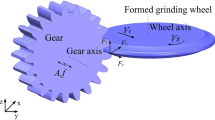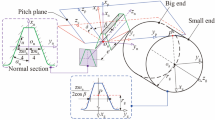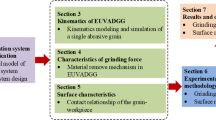Abstract
Due to complex geometry and movement involved in continuous generating gear grinding, the grinding worm wear characterization is different from that in regular grinding processes. Grinding worm wear evaluation with accumulated removed material volume was investigated through wear status evolution experiments. By changing grinding parameters in orthogonal experiments, grinding worm surfaces with various wear status and their resulting gear surface roughness were obtained. The results show that the fractal dimension could be used to roughly quantify grinding worm wear status. A nearly linear relationship was found between the fractal dimension and the removed material volume. Grinding speed, normal stock, feed rate, and shifting value were proven to have great influence on grinding worm wear. A significant negative correlation was found between the fractal dimension and surface roughness. However, due to shifting movement, both coarse grinding parameters and finished grinding parameters can affect gear surface. Smaller fractal dimensions were found to result in smoother gear surfaces and vice versa. Based on the result, grinding parameters in continuous generating grinding were recommended. Grinding speed should be as high as possible considering the machine tool capability. Normal stock of 0.02–0.09 mm, feed rate of 50–100 mm/min, and shifting value of 7 mm should be adopted in finished grinding.












Similar content being viewed by others
Data availability
The datasets used or analyzed during the current study are available from the corresponding author on reasonable request.
References
Karpuschewski B, Knoche HJ, Hipke M (2008) Gear finishing by abrasive processes. CIRP Ann 57:621–640
Berend D, Jens K, Andreas S, Stephan W (2014) Continuous generating grinding — material engagement in gear tooth root machining. Mech Mach Theory 81:11–20
Kurt TH, Berend D (2013) Gear grinding. In: Basics of cutting and abrasive processes. Lecture Notes in Production Engineering. Springer, Berlin, Heidelberg, pp 303–323
Berend D, Thilo G, Vino S (2020) New profiling approach with geometrically defined cutting edges for sintered metal bonded CBN grinding layers. J Mater Process Technol 278:116473
Haidara MA, Ishibashib A, Sonodab K, Ezoec S (1999) Minimization of effect of CBN wheel wear on ground gear errors. Int J Mach Tools Manuf 39:607–626
Zhou W, Tang J, Chen H, Shao W, Zhao B (2019) Modeling of tooth surface topography in continuous generating grinding based on measured topography of grinding worm. Mech Mach Theory 131:189–203
Tianyu Y, Bastawros AF, Abhijit C (2017) Experimental and modeling characterization of wear and life expectancy of electroplated CBN grinding wheels. Int J Mach Tools Manuf 121:70–80
Dai C, Ding W, Xua J, Fu Y, Yu T (2017) Influence of grain wear on material removal behavior during grinding nickel-based superalloy with a single diamond grain. Int J Mach Tools Manuf 113:49–58
Jeffrey B, Stuart M, O’Donnell GE (2021) Big-and-dull or small-and-sharp: a comparison of specific energy, wheel wear, surface-generation mechanisms and surface characteristics when grinding with Al2O3 and CBN to achieve a given surface roughness. J Mater Process Technol 288:116825
Ophey M, Löpenhaus C, Klocke F (2015) Influence of tool specification and machining parameters on the wear behaviour at generating gear grinding. Appl Mech Mater 794:231–238
Jeffrey B, Stuart M, O’Donnell GE (2018) Acoustic emission in dressing of grinding wheels: AE intensity, dressing energy, and quantification of dressing sharpness and increase in diamond wear-flat size. Int J Mach Tools Manuf 125:11–19
Kannan K, Arunachalam N, Chawla A, Natarajan S (2018) Multi-sensor data analytics for grinding wheel redress life estimation – an approach towards Industry 4.0. Procedia Manufacturing 26:1230–1241
Lee ET, Fan Z, Sencer B (2021) Estimation of cBN grinding wheel condition using image sensor. Procedia Manufact 53:286–292
Lee ET, Fan Z, Sencer B (2020) Real-time grinding wheel condition monitoring using linear imaging sensor. Procedia Manufact 49:139–143
Lemes RR, Claudio LJ, Vinícius GM, Eduardo TG, Roger RA, d Eduardo ÂSL, d José MH, d Roberto AP, Carlos BE (2020) Grinding process applied to workpieces with different geometries interrupted using CBN wheel. Int J Adv Manufact Technol 107:1265–1275
Ding W, Dai C, Yu T, Xu J, Fu Y (2017) Grinding performance of textured monolayer CBN wheels: Undeformed chip thickness nonuniformity modeling and ground surface topography prediction. Int J Mach Tools Manuf 122:66–80
Wang D, Ge P, Bi W, Jiang J (2014) Grain trajectory and grain workpiece contact analyses for modeling of grinding force and energy partition. Int J Adv Manufact Technol 70:2111–2123
Zhu Y, Ding W, Rao Z, Zhao Z (2019) Self-sharpening ability of monolayer brazed polycrystalline CBN grinding wheel during high-speed grinding. Ceram Int 45:24078–24089
Majumdar A, Bhushan B (1990) Role of fractal geometry in roughness characterization and contact mechanics of surfaces. Trans Asme J Tribology 112:205–216
Chen Z, Liu Y, Zhou P (2018) A comparative study of fractal dimension calculation methods for rough surface profiles. Chaos, Solitons Fractals 112:24–30
Liu Y, Wang Y, Chen X, Zhang C, Tan Y (2017) Two-stage method for fractal dimension calculation of the mechanical equipment rough surface profile based on fractal theory. Chaos, Solitons Fractals 104:495–502
Malkin S, Aanderson RB (1974) Thermal aspects of grinding part 1 – energy partition. J Eng Industry 96:1177–1183
Shaw MC (1996) Principles of abrasive processing. Oxford University Press
Malkin S (1974) Thermal aspects of grinding part 2 – surface temperatures and workpiece burn. J Eng Industry 96:1184–1191
Denkena B, Schindler A, Woiwode S (2016) Calculation method of the contact area in flank machining for continuous generating grinding. Appl Math Model 40:7138–7146
Dai C, Yu T, Ding W (2019) Single diamond grain cutting-edges morphology effect on grinding mechanism of Inconel 718. Precis Eng 55:119–126
Yu T, Cheng J, Gao C, Wu J, Guo Z (2022) Modeling and experimental study of different discontinuous micro-grinding tools. Int J Adv Manufact Technol 107:4009–4032
Chen S, Cheung CF, Zhang F, Zhao C (2018) Three-dimensional modelling and simulation of vibration marks on surface generation in ultra-precision grinding. Precis Eng 53:221–235
Naik DN, Mathew NT, Vijayaraghavan L (2019) Wear of electroplated super abrasive CBN wheel during grinding of Inconel 718 super alloy. J Manuf Process 43:1–8
Snoeys R, Maris M, Peters J (1978) Thermally induced damage in grinding. Ann CIRP 27:571–581
Toru K, Toshifumi K, Masashi O, Fukui R (2019) Direct observation and analysis of heat generation at the grit-workpiece interaction zone in a continuous generating gear grinding. CIRP Ann Manuf Technol 68:417–422
Nastja MPFLF, Peter K (2020) Effect of the grit shape on the performance of vitrified-bonded CBN grinding wheel. J Mat Process Technol 277:116453
Funding
This work was supported by the National Key R&D Program of China (No. 2019YFB1703700).
Author information
Authors and Affiliations
Contributions
Yijie Tao carried out the experiment and contributed significantly to date analysis. Guolong Li proposed the method to experimentally investigate grinding worm wear and helped perform the analysis with constructive discussions. Bing Cao helped to observe gear surfaces and duplicates. Lin Jiang helped to perform the experiment.
Corresponding author
Ethics declarations
Competing interests
The authors declare no competing interests.
Additional information
Publisher's note
Springer Nature remains neutral with regard to jurisdictional claims in published maps and institutional affiliations.
Rights and permissions
Springer Nature or its licensor (e.g. a society or other partner) holds exclusive rights to this article under a publishing agreement with the author(s) or other rightsholder(s); author self-archiving of the accepted manuscript version of this article is solely governed by the terms of such publishing agreement and applicable law.
About this article
Cite this article
Tao, Y., Li, G., Cao, B. et al. Grinding worm wear evaluation and its influence on gear surface topography in continuous generating gear grinding. Int J Adv Manuf Technol 123, 3301–3311 (2022). https://doi.org/10.1007/s00170-022-10368-z
Received:
Accepted:
Published:
Issue Date:
DOI: https://doi.org/10.1007/s00170-022-10368-z




